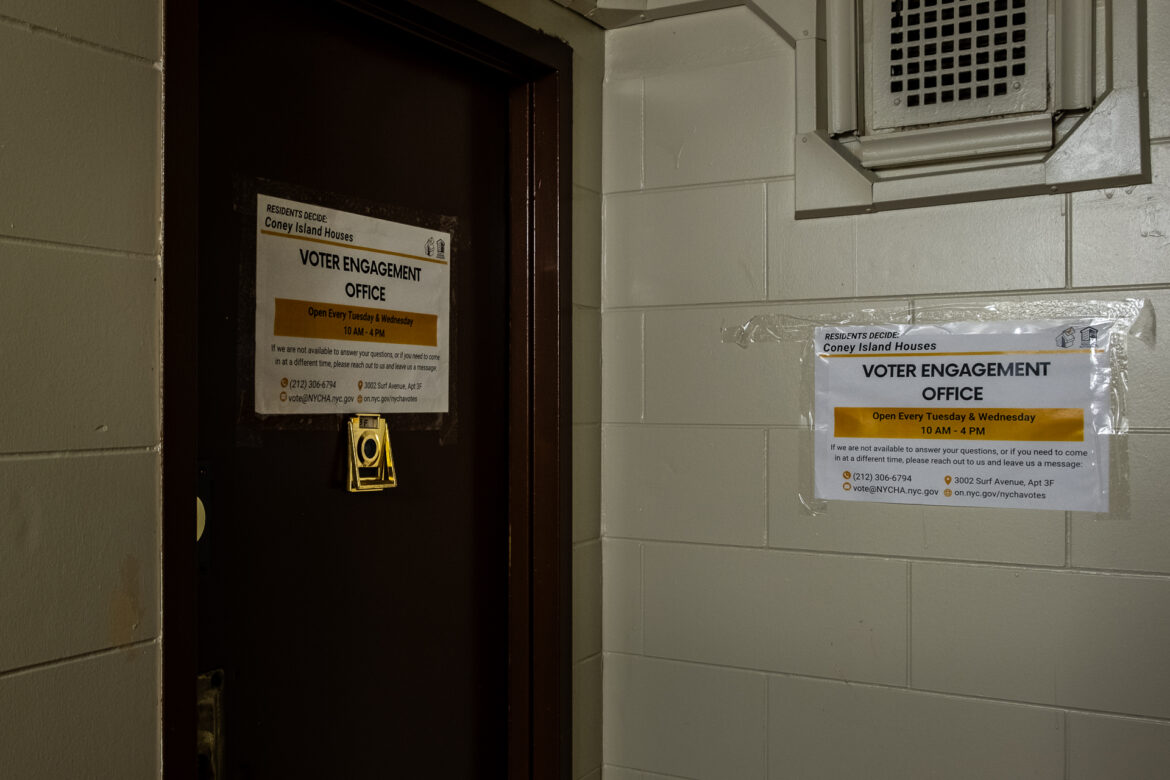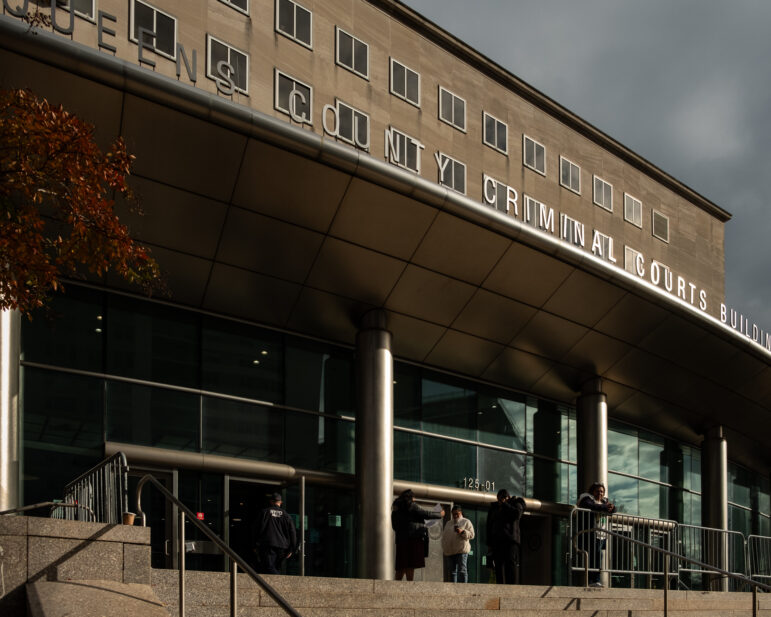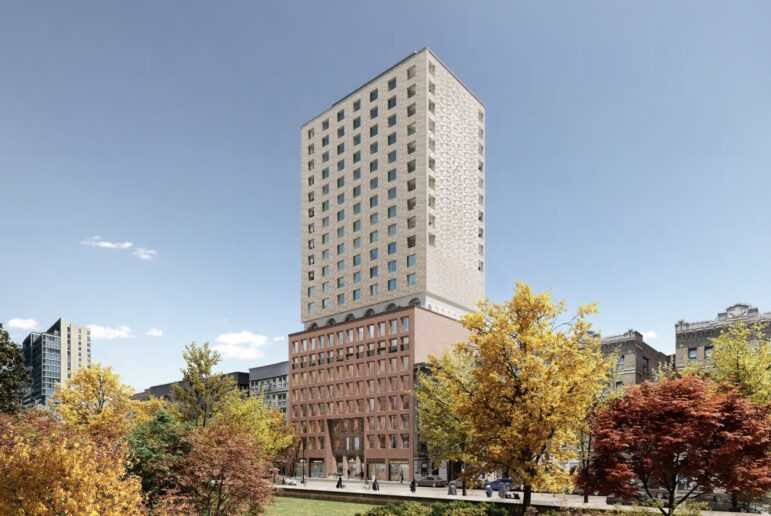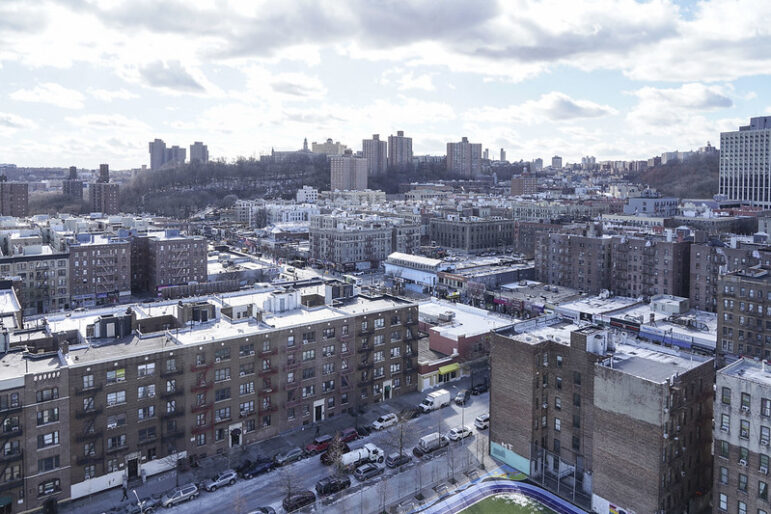For the third time, NYCHA residents are voting on which funding model they believe best meets the needs for their complex. Residents at Coney Island Houses and Unity Towers can cast their votes starting Wednesday through Aug. 15.

Adi Talwar
The “Voter Engagement Office” at Coney Island Houses, where tenants can learn about options on their ballots.Another vote within two NYCHA communities is underway.
Tenants living in Coney Island Houses and Coney Island I (Site 1B) Houses, also known as Unity Towers, are joining close to 1,800 NYCHA residents who’ve been previously asked to vote on the future of their developments.
Starting Wednesday at noon, Coney Island residents can choose between three funding modes for their campus. They follow similar votes held over the last year at the Nostrand Houses in Sheepshead Bay and the Bronx River Addition Houses in Soundview.
More than 700 households are eligible to vote on the next chapter in two separate elections being held simultaneously: one for the five residential buildings of Coney Island Houses, and another for Unity Towers at 2007 Surf Ave.
The waterfront developments—located in Southwest Brooklyn, home to Luna Park and the famed Coney Island beach and boardwalk—have a 20-year capital need of $230 million and $83 million, respectively, according to NYCHA.

Adi Talwar
A view of NYCHA’s Coney Island Houses campus from the Coney Island Boardwalk.Melissa Jones, who has lived at the Coney Island Houses her entire life, said conditions there have deteriorated with time, particularly during and after Hurricane Sandy, which landed in New York City in October 2012.
During the storm, flooding swamped the basements, disrupting electricity and heat.
“The smell was horrendous,” Jones said of the superstorm’s aftermath. “A lot of people got sick from that because it took [NYCHA] housing a very long time to clean out the first floor, where it was all molded.”
In 2017, NYCHA broke ground on post-Sandy repairs at Coney Island Houses, including new roofs, boiler systems and playground areas.
The upgrades are part of a larger project to rehabilitate 33 NYCHA developments that saw Sandy destruction through $3 billion from the Federal Emergency Management Agency, with $95 million earmarked for Coney Island and $30 million for Unity Towers. Those post-Sandy rehabilitation efforts are “substantially complete” at both developments as of April, according to NYCHA.
But the campuses need additional funding for other fixes. Outside of Hurricane Sandy damage, Jones told City Limits that Coney Island Houses can benefit from having more consistent day-to-day maintenance.
“Sometimes we don’t even have people come and clean the building,” said Jones. “Some weekends the buildings are all dirty from Friday all the way to Sunday.”
Another Coney Island resident who asked for City Limits to withhold her name said there are “a lot of things going on” in terms of outstanding repairs in her building.
“You’ve got the cabinets, most of the pipes, some people have leaks, and some people haven’t had a paint job in years,” the West 29th Street tenant said.
Kitchens, bathrooms, floors, ceilings and paint jobs are among the highest needs for the Brookln campuses, according to a NYCHA presentation, upgrades which would cost an estimated $110 million at Coney Island and more than $42 million at Unity Towers.
Janice Wingate, a longtime resident of Unity Towers, cited frustrations over poor maintenance. In the morning, she has to run the water for about a minute before it gets warm, she said. When entering her building on multiple occasions, she’s seen her wheelchair-bound neighbors stuck in the lobby due to broken elevators.
“I have to call the CCC [Customer Contact Center] every single day,” Wingate said.

Adi Talwar
NYCHA’s Unity Towers at 2007 Surf Ave, Brooklyn.In recent years, NYCHA has turned to new funding methods to address $78.3 billion in capital repair needs for all of its 58,563 apartments over the next 20 years. Voters will have three options on their ballot.
The first is to join the Public Housing Preservation Trust, signed into law by Gov Kathy Hochul in June 2022. Under this initiative, NYCHA properties convert from traditional Section 9 public housing to Section 8.
This conversion allows for units to transfer into a new entity, the Trust, which can issue bonds to fund repairs. Though the funding stream is different from public housing, the properties will continue to be managed by NYCHA.
The second option is the Permanent Affordability Commitment Together (PACT) program, introduced in New York City in 2016 as part of a nationwide initiative, called the Rental Assistance Demonstration (RAD), to rehabilitate aging public housing structures.
Similar to the Trust, NYCHA properties would convert from Section 9 to Section 8. The difference, however, is that an outside management company takes over the daily operations, ranging from maintenance work to rent collection. Meanwhile, NYCHA continues to own the land.
The third option would be to remain as a Section 9 property. NYCHA would continue to manage the properties under the current funding stream, which gets an estimated $700 million annually from Congress toward renovations across its entire portfolio—just a “fraction” of what it actually needs, according to the housing authority.
For each option, tenants will continue to pay no more than 30 percent of their income on rent. In order for the vote to count, at least 20 percent of households must participate. (In previous elections at the Nostrand and Bronx River Addition Houses, the majority of voters chose the Trust.)
Residents at the Coney Island Houses and Unity Towers can begin voting either online or by mail on Wednesday at noon, and voting will remain open until Aug. 15 at 9 p.m.
A period of in-person voting will kick off on Aug. 6. Coney Island residents can drop their ballot off at 3030 Surf Ave. in the Tenant Association (TA) room. Residents at Unity Towers can vote in person at 2007 Surf Ave. in the TA room located on the first floor.
In-person voting hours are between 12 and 8 p.m., with hours extended between 11 a.m. and 9 p.m. on the last day.
To reach the reporter behind this story, contact Tatyana@citylimits.org. To reach the editor, contact Jeanmarie@citylimits.org
Want to republish this story? Find City Limits’ reprint policy here.







